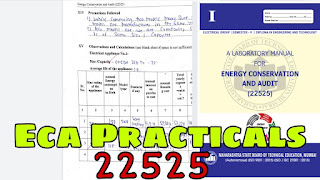ECA 22525 - Energy Conservation and Audit Practical All
What is Energy Audit?
An energy audit is an analysis of energy flows for energy conservation and to find energy losses. It is a process by a collection of detailed data related to energy usage and comparison of collected results.
An energy audit is a process by which we can reduce the amount of energy input to the system without a negative impact on the output. It must be the first step in commercial and industrial real estate to identify an opportunity to reduce the billing cost and waste of energy.
It measures various data like total connected load, power factor, load factor, and maximum demand. All the calculations result in the investment required in terms of the payback period.
Need for Energy Audit and Management
As we have discussed, an energy audit is a process to find data and readings to identify energy-saving opportunities with excess use of energy compared with set up standards.
It is a master tool of energy management to use energy efficiently. It is a method to find out the way by which we can reduce our power consumption.
Steps of Energy Audit
The energy audit includes the following steps to analysis of plant;
- Collect past data of energy usage.
- Study of plant, industries, or building and their operational characteristic.
- Identification of opportunities to reduce energy uses and cost.
- To perform analysis of potential modification.
- Prepare a priority-wise list of modifications.
- Prepare an audit report to document the analysis process and results.
Cost-effective Energy Conservation Ideas
Energy can be saved by using advanced technology equipment with some human efforts. The list of some ideas to save energy is listed below;
- Use of LED lights instead of fluorescent lamps. It will reduce 70% of energy consumption from lighting.
- Install lighting sensors or smart lights, which can automatically turn ON and OFF.
- Use energy efficient equipment like Electric Motor, etc.
- Install photosensors in public lighting like street lights.
- Use natural light, if possible. Keep in mind while planning new construction to place a window at a place. Hence you can use the sunlight during day time. And turn off lights if is not required.
- Turn OFF all equipment while leaving the area or hall. Make a banner to switch off lights while you leaving.
- Use energy-efficient fans (BLDC Fans) to reduce the energy. The consumption of BLDC fan is 28-35W while ordinary fan consumes 70-80W.
- Turn OFF cooling and heating elements 10-15 minutes before you are leaving.
- Install a master switch outside of the room. Therefore, you can turn off all equipment in case you forgot to turn it off from inside.
- Use inverter AC and Fridge to reduce energy consumption.
- Use motion sensors in public lights like underground parking, corridor, etc.
- Proper installation of window, curtain, glass film will reduce the use of lights and fans.
- Use advanced components and continuous maintenance make the plant energy efficient.
- Install proper size of equipment. For example, use small size AC (1-1.5 ton) for a small room. If you install high-cap
DOWNLOAD LINK






0 Comments